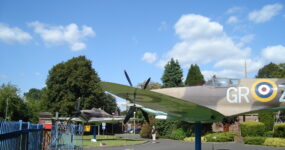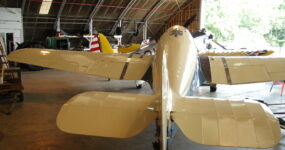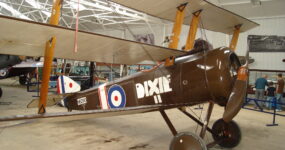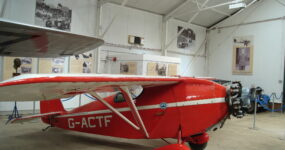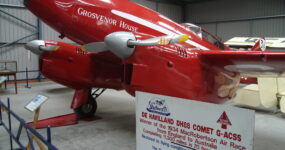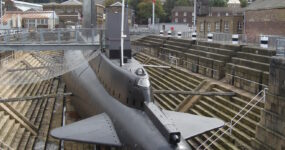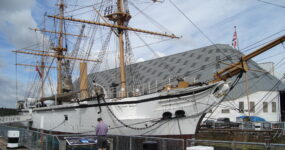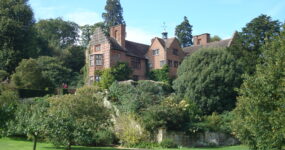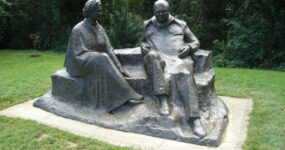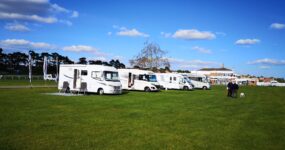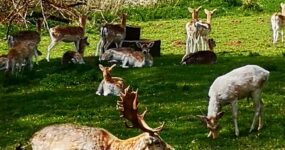Jenny and Arthur discover ‘Planes, Ships and History in S.E. England
After leaving the excellent Inland Waterways rally we decided to stay on in the East of England to tick off some of the places that were on our “Must Visit One Day” list and combine it with a visit to Chelmsford where Jenny’s brother and wife live. We had already visited Ely and its magnificent cathedral whilst at St. Ives so next on our hit list were the RSPB Headquarters and Reserve at Sandy in Bedfordshire and the Shuttleworth Collection at Old Warden.
For this trip we had our Ford `KA’ with us and although we used it to get out and about it’s worth noting that all the places we visited in this report were motor-home friendly with easy access and parking. We had pre-booked the Caravan Club CL sites which we like to use.
The first CL at Blunham near Sandy was on an ex market-garden farm with a very nicely kept level field adjacent to the farmhouse. Water, electric hook-up and chemical emptying were all available and easy. The site looked out over very pleasant open fields with horses grazing. The downside was the rather busy road which did cause some noise.
We visited The RSPB at Sandy which has a very attractive old manor house as its headquarters and very nice grounds and gardens with walks and bird hides. There is also an excellent shop and visitor Centre.
The following day we spent visiting the Shuttleworth Collection. Richard Shuttleworth was the son of a wealthy factory owner and he loved speed. The collection is centered on some of the cars, motorbikes and aeroplanes that he owned. The unique collection of over 40 aircraft all in flying condition is housed within 8 hangars, Visitors can see the history of the aeroplane from the early days of flying through WW1 and WW2. There is also a Swiss Garden, a large Bird of Prey Centre and Owl Sanctuary, a children’s play park, picnic area and a shop and café. We had a very enjoyable day there and would like to return on one of their “Flying Days”.
Next we were off to Chelmsford and to stay on our usual CL at Little Baddow Fruit Farm. The farm when we first stayed had a huge amount of all types of fruit and vegetables. Now they no longer do soft fruit and most of the fields are let out for horse grazing and there is now a second CL site on the farm. The sites are level and well serviced. There is a very pleasant walk from the site to Little Beddow or a longer circular walk, It is very quiet and peaceful and has a small lake for fishing.
After a couple of days at Chelmsford it was time to move on and next on our agenda was St. Mary Hoo on the Isle of Grain! Where on earth is that and why there? Well it was the nearest CL we could find to the Chatham Historic Dock Yard – the next place on our “Must Do” list. The Isle of Grain is the bit of England that has the River Thames Estuary on one side and the River Medway on the other with Rochester at its head. It’s not really an island but almost.
The CL is attached to the “Old Fen Bell Inn” near St. Mary Hoo. The site was rather unkempt with long grass, overhead cables and a few well lived-in caravans. It was also home to a herd of goats who promptly invited themselves into our van as soon as the door was open! The whole place was in need of some TLC. However, the owners and locals were very friendly, the goats were not a real problem and the owners of the caravans were men working in the huge power stations that are a dominant feature of the landscape in this area. We had an excellent meal in the pub which is very old and unchanged. We spent 3 nights at this CL at £7.00 a night incl. H/U. We explored the area driving to the headland at Grain where the Grain Tower can be seen in the estuary and at low tide there is a causeway out to it. It was a WW2 fortification. All around this coastline is a concrete causeway which is wonderful for walking and cycling, It was built during the war as part of the sea defence system. We spent a very pleasant couple of hours sitting on the beach watching the huge container and ferry ships ploughing up and down the two estuaries. Mixed up amongst the large ships were a variety of small sailing yachts, sailing dinghies and pleasure boats.
The following day we decided to explore the area further wanting to have a look at the Fens and hopefully see some birdlife. We came across a country show run by the RSPB at their site near Cooling and had a very enjoyable few hours there. There were lots of local stalls displaying all types of handicrafts, local skills, produce, wine, beer and cider plus history local to the area, sheep shearing, pony rides, coconut shy, RSPB info, all sorts of Animal Trusts and lots more. But NO commercial stalls – just how a country fair should be – it was marvellous. We had a lovely walk overlooking the fens and spotted lots of birds including a Spoonbill and Marsh Harriers.
We then went on to visit Cooling Castle or what is left of it! It’s now home to jazz pianist Jules Holland. There was a bridal fair exhibition being held in the grounds and we were invited in to have a look around (didn’t tell them we’ve been married for 43 years) and with Arthur drooling over the beautiful collection of Rolls Royce wedding limousines, including two superb Silver Ghosts, we wandered nonchalantly around the exhibition in our T-shirts and shorts trying to blend in amongst the very smartly dressed guests!
Next morning we were off site early for the short drive to Chatham Historic Dockyard where we spent the whole day and still did not see everything! it’s worth noting that an entrance ticket can be used again and again for 1 year.
For 400 years the dockyard and naval base played a crucial role in supporting the Royal Navy in the defence of Britain and the development of the Empire and Commonwealth. In 1558 Chatham prepared the ships of the Elizabethan Navy for battle against the Spanish Armada. In 1908 Chatham embraced new technology, building fifty-seven submarines in the following fifty-four years. The end of the Cold War led to the dockyard’s closure in 1984.
Today the Historic Dockyard is a unique place to visit, with historic warships HMS Cavalier 1944, HMS Submarine Ocelot 1962 and HMS Gannet 1878 and a Ropery where rope has been made since 1618 and is still being made today. The Museum of the Royal dockyard offers a fascinating insight into the history of the yard, from its origins in the time of Henry V111 through to its part in the Falklands crisis. The Wooden Walls gallery recreates the sights, sounds and smells of the dockyard of 1758. Lifeboat! tells the 170 year story of the Royal National Lifeboat Institution through its own collection of historic lifeboats, archive film and artefacts. With many other areas of interest to visit it would be impossible to see it all in one day. There is even a trip along the Medway in an historic paddle steamship but sadly it was not running on the day we visited. We hope that we get the chance to visit again to see the bits we missed and to have a trip on the Paddle Steamer.
Next Morning we said goodbye to our four-legged friends and set off for the final “Must Do”, Chartwell and our final CL at Westerham Heights Farm near Westerham in Kent. This was the best CL so far as it was set behind a beautiful old period farmhouse on a level green field site. There are only basic facilities but at only £2.00 per night it’s very good value. As we had arrived by lunchtime and planned to spend the whole of the following day at Chartwell we spent the afternoon visiting the Biggin Hill St George’s Chapel of Remembrance – a moving tribute to all the aircrew who died flying from the Biggin Hill Sector during WVV2. There are 17 beautiful stained glass windows and many mementoes of those who served in the RAF and Allied Services. The entrance is guarded by replicas of a Spitfire and a Hurricane which flew from the airfield. We then drove on to Box Hill, now owned and managed by the National Trust and affording fantastic views from a high ridge across the South Weald to the distant hills. We were fortunate enough to be there on a perfect summer evening with a wonderful sky and setting sun.
A short drive the next morning took us to Chartwell, the home of Sir Winston and Lady Churchill. Sir Winston purchased the Chartwell estate in 1922 in poor condition and, apart from during the Second World War, spent as much time as he could there until his death in 1965. Rooms in the house reflect the heyday of the family at Chartwell in the 1920’s and ’30s. The house incorporates a museum room on the first floor and an exhibition on the lower ground floor. The studio displays over 130 of Sir Winston’s paintings. The gardens offer magnificent views over the Weald of Kent and include Lady Churchills rose garden and the Nemon statue by the lake. We both enjoyed our visit to Chartwell which brought back many memories of the war years to both of us. Chartwell was the last of our Must Do’s on this trip. We had really enjoyed our Tour of the Eastern Counties, the history – the forgotten places – the estuaries and the wildlife. Jenny
NB the CL charges reflect the year that I wrote this report, probably a lot more now!
Photos: Biggin Hill, The Shuttleworth collection, Chatham Dockyard and Chartwell
Click on images to enlarge.
